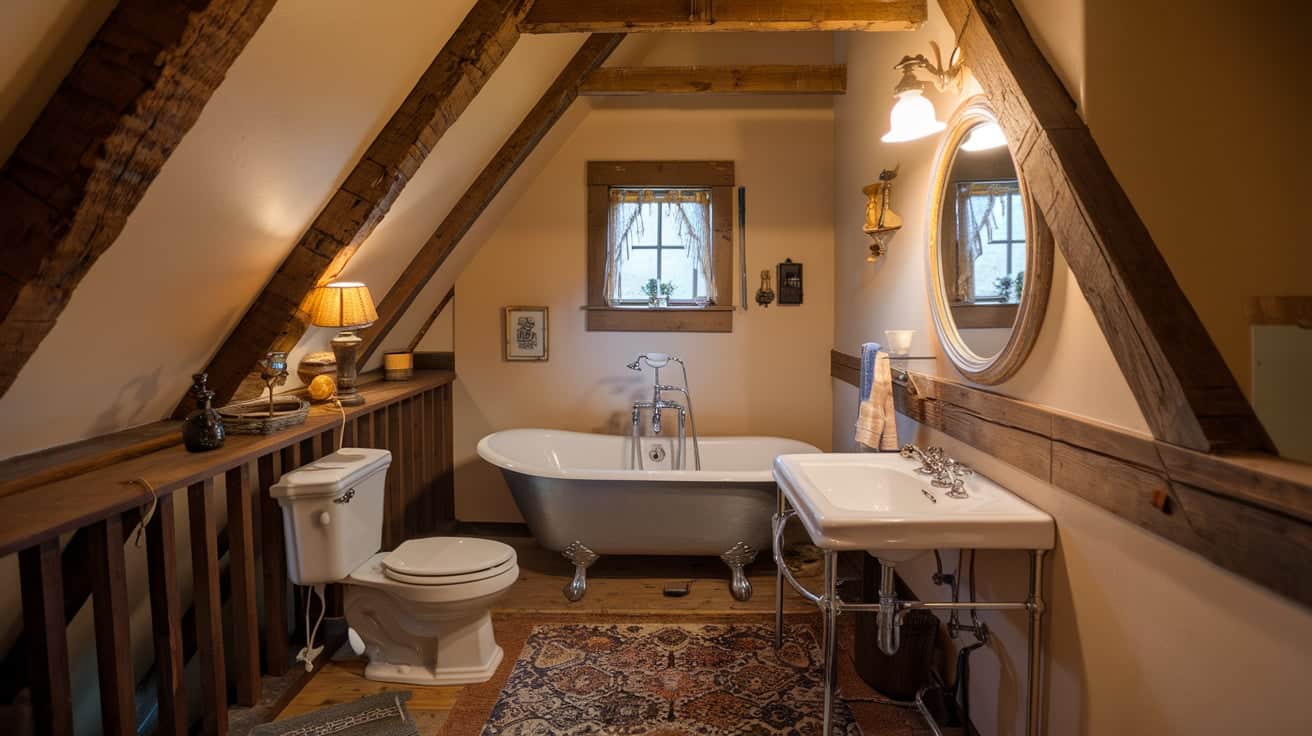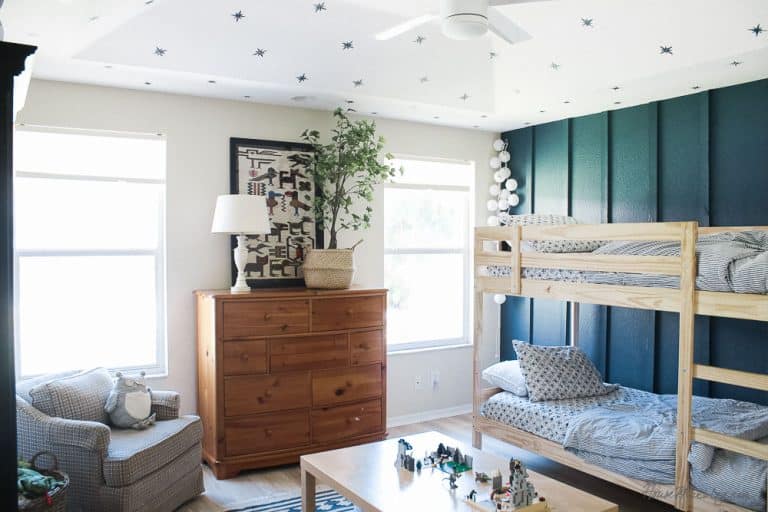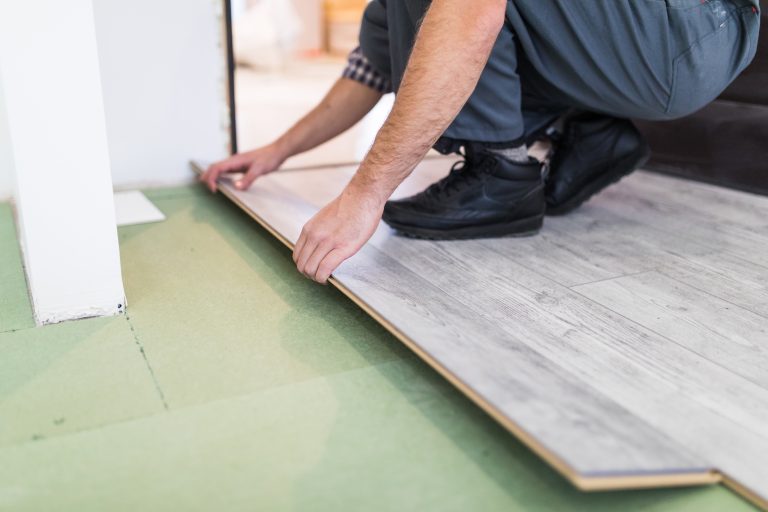8 Private and Peaceful Upstairs Bathroom
There’s something undeniably sacred about the upstairs bathroom—a private sanctuary often overlooked in home design discussions. Behind that unassuming door lies the potential for your most intimate retreat, a place where the world fades away the moment you turn the lock.
What secrets could your upstairs bathroom be hiding? What conversion awaits this overlooked space? We seek moments of solitude in the quiet corners of our homes.
The upstairs bathroom—removed from household traffic and prying eyes—offers the perfect canvas for creating the peaceful haven you crave. Whether you’re taking a five-minute breather from family chaos or a luxurious hour-long soak, this space holds the power to restore your equilibrium.
But achieving this sense of private tranquility requires intention. I’ll guide you through inspired ideas to change your ordinary upstairs bathroom into an extraordinary personal sanctuary that speaks to your soul. Let me show you how.
Upstairs Bathroom Layout Ideas for a Relaxing Retreat
Creating the perfect layout for your upstairs bathroom involves balancing functionality with a serene atmosphere. Here are a few ideas to maximize space while ensuring a peaceful, retreat-like feel:
1. Open and Spacious Layout

Consider an open layout that integrates the bathtub, shower, and vanity into a single flowing space. This layout reduces clutter and promotes a calm, expansive feel.
2. Separate Bath and Shower Zones

If space allows, consider separating the bathtub and shower into distinct areas. This gives a spa-like feel, with both spaces offering privacy and comfort.
3. Floating Vanity and Storage

Install a floating vanity to create a sense of openness and increase floor space. Combine this with clever built-in storage solutions to keep essentials organized and out of sight.
4. Dual Sinks for Shared Comfort

If your upstairs bathroom is shared, install dual sinks to avoid congestion. This layout enhances both convenience and tranquility, offering everyone their own space.
5. Skylights and Natural Light

Position your shower or bathtub beneath a skylight to take advantage of natural light, making the space feel airy and connected to the outdoors.
6. Corner Tub and Shower Combo

In smaller spaces, consider a corner bathtub and shower combo. This maximizes space while still providing separate areas for relaxation and rejuvenation.
7. Sliding Doors for Space Efficiency

Use sliding doors for the bathroom or shower to save space and reduce the need for swinging doors, helping maintain the room’s open, uncluttered feel.
8. Calming Color Zones

Designate areas for different activities with calming colors and soft textures. For example, the bathtub area can be soothing with cool blues, while the vanity area can have warm neutrals for comfort.
Designing an Upstairs Bathroom for Privacy and Peace
-
Natural Separation: The upstairs location of a bathroom naturally creates distance from the more active areas of your home, such as the living room or kitchen. This separation offers a serene and quiet space where you can enjoy privacy and solitude, making it an ideal spot for relaxation.
-
Sound Block: To further enhance privacy, consider installing a solid-core door. Solid-core doors are better at blocking sounds so that you won’t be disturbed by household noise, and others won’t hear noises coming from your bathroom. This ensures a peaceful and private environment for your self-care time.
-
Light Without Exposure: You don’t have to choose between natural light and privacy. Frosted window film can be applied to bathroom windows, allowing daylight to pour in without sacrificing your privacy. This solution ensures the space stays bright and airy while protecting you from outside view.
-
Background Noise: For added tranquility, consider installing a white noise machine or a small speaker that plays calming background sounds, such as soft music or nature noises. This not only blocks out the sound from other parts of the house but also creates a more peaceful and relaxing atmosphere inside the bathroom.
-
Clear “Occupied” System: To avoid interruptions, establish a clear system for others in the house to know when the bathroom is in use. A simple “occupied” sign on the door or a signal, such as a light, can help prevent awkward situations and give you the peace of mind that no one will walk in unannounced.
Incorporating Calming Elements: Textiles, Plants, and Scents

Soft textures, living plants, and pleasant scents change a basic bathroom into a serene space where you can relax. These simple additions appeal to your senses and increase the overall comfort of your environment.
- Soft Textiles: High-thread-count towels, plush mats, and soft bathrobes enhance comfort. Washable shower curtains and throw blankets add texture and warmth.
- Plants: Aloe vera, spider plants, and ferns thrive in bathrooms, purifying the air. Snake plants and bamboo are low-maintenance and ideal for small spaces.
- Scents: Lavender, eucalyptus, and vanilla promote calmness, while lemon and jasmine offer freshness and a spa-like ambiance.
- Ways to Add Scents: For fragrance, use reed diffusers, essential oil sprays, candles, or sachets.
- Bringing It Together: Match colors, place plants at different heights, and rotate scents to create a harmonious atmosphere.
How to Create the Perfect Ambiance?

1. Lighting Affecting Your Mood
Lighting plays a crucial role in the atmosphere of your bathroom. Bright, intense lighting is great for energizing mornings, while soft lighting helps you unwind in the evening. Combining both will create a balanced, peaceful environment.
2. Colors That Create Calm
- Blues & Greens: These colors remind us of water and nature, creating a calming, serene atmosphere. Light blues can help a small bathroom feel more spacious, while soft greens add a fresh, rejuvenating touch.
- Warm Neutrals: Shades like beige, tan, and cream bring comfort and warmth to the space. These tones pair well with either cool or warm accent colors, making them versatile.
- White: It is a classic color that evokes an open, clean feeling. Pair it with natural wood elements for added warmth and texture.
3. Making the Most of Natural Light
Use sheer curtains to let in light while maintaining privacy. Place a mirror opposite the window to reflect the sunlight around the room. Keep window sills clear to prevent blocking light.
4. Creating Soft Lighting
To enhance your bathroom’s retreat-like atmosphere:
- Install dimmer switches for adjustable lighting.
- Add wall sconces at eye level to create a softer ambiance and minimize shadows.
- Place small lamps on counters or shelves to add a cozy, warm glow.
Conclusion
Small changes to your upstairs bathroom can make a real impact on your daily routine. By focusing on lighting, fixtures, storage, and comfort items, you can build a spot that helps you slow down and breathe.
The right colors and lights set the stage. Good fixtures make each use more pleasant. Smart storage keeps things tidy—plants, soft towels, and nice scents round out the feeling of a special place.
Remember that your bathroom can be more than just a washing space. It might become your reading corner, thinking spot, or self-care station.
The time you spend fixing up this room pays off each day as you step into a space that feels made just for you.







